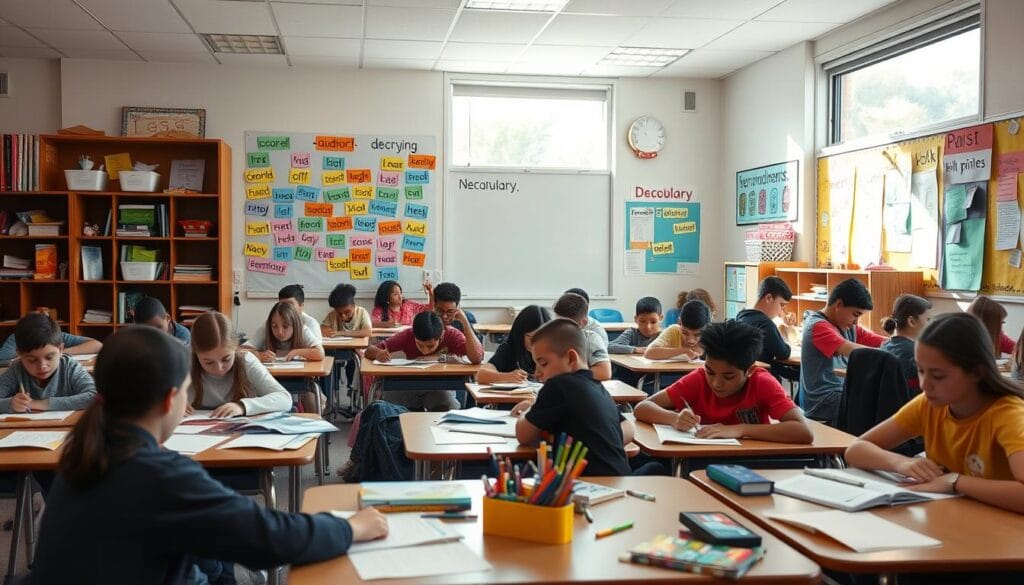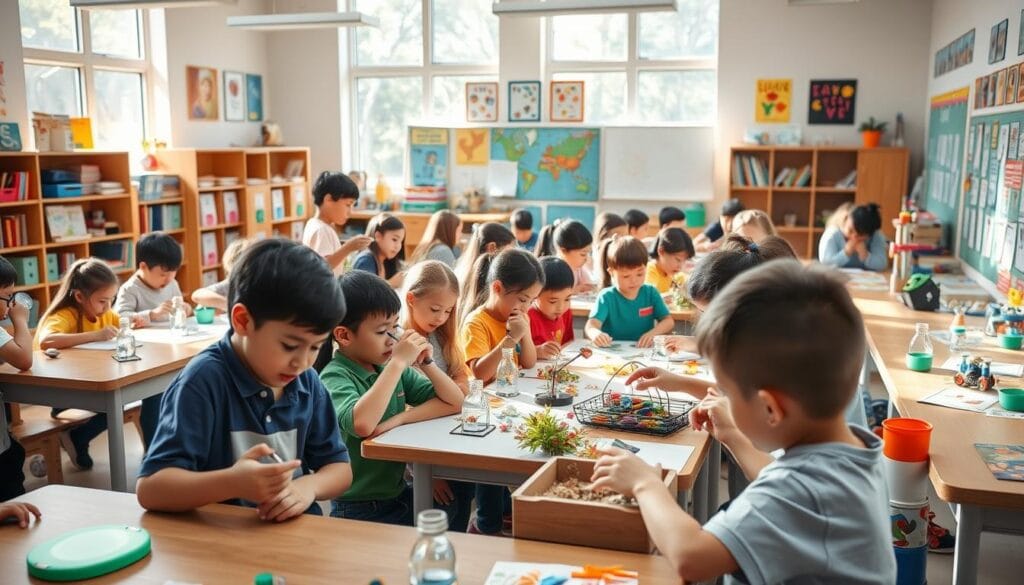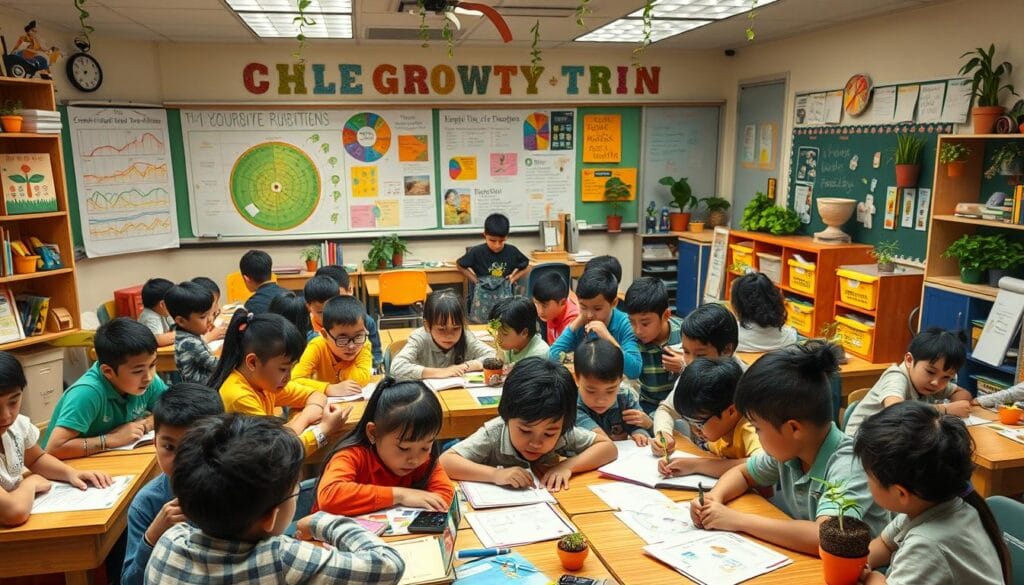Powerful Ways to Ignite Student Curiosity and Love for Learning
As an educator, your main goal is to make students love learning. By sparking their curiosity, you can help them reach their full potential. This article will show you how to create a classroom where students are excited to learn and grow.
Teaching isn’t just about sharing facts; it’s about making learning exciting. When you tap into students’ natural love for learning, you’ll see big changes. They’ll become more engaged, motivated, and do better in school.
فهرس المقالة
Understanding the Foundation of Student Curiosity
Starting a student’s curiosity is key to loving learning and thinking critically. We need to look into why students are naturally curious. This helps us understand how to keep them motivated to learn.
The Psychology Behind Natural Learning Instincts
Humans are naturally curious. We want to explore and understand our world. This curiosity is part of who we are, thanks to our evolution.
When students follow their curiosity, they learn better. They remember more and think more critically.
Barriers to Curiosity in Traditional Education
Traditional schools can make students less curious. They focus too much on memorizing and passing tests. This can make students less interested in learning.
It stops them from seeing challenges as chances to grow. Instead, they see them as obstacles.
The Role of Neuroscience in Learning Motivation
Neuroscience helps us understand why students are motivated to learn. When students are curious, their brains release dopamine. This makes them enjoy learning more.
This connection helps students learn better. It makes them more curious and open to new ideas.
Knowing how curiosity works helps teachers create better learning spaces. These spaces inspire students to keep exploring and loving to learn.
Fostering Student Curiosity Through Inquiry-Based Learning
Inquiry-based learning is a great way to spark student curiosity. It lets students ask questions, explore topics, and learn deeply. They get to do the learning themselves, with a little guidance.
Teachers can make learning fun by creating places where students can explore. This way, students get excited about what they’re learning. They also learn to think critically, analyze information, and come up with their own conclusions.
- Promote student-led investigations and hands-on activities that ignite their curiosity.
- Encourage open-ended questions and provide opportunities for students to explore and find their own answers.
- Facilitate collaborative discussions where students can share their findings, insights, and diverse perspectives.
- Incorporate technology and digital tools that enable interactive and immersive learning experiences.
When students are involved in their learning, they become more curious. This leads to a deeper understanding of what they’re studying. Inquiry-based learning makes learning fun and can inspire a lifelong love of it.
“The important thing is not to stop questioning. Curiosity has its own reason for existence.” – Albert Einstein
Creating Dynamic Learning Environments That Spark Wonder

Designing the learning environment is key to sparking student curiosity. It’s where experiential education and active learning strategies come alive. Spaces that encourage exploration, creativity, and hands-on learning are essential.
Designing Interactive Learning Spaces
Well-designed learning spaces open up a world of wonder for students. Use flexible seating, collaborative areas, and spaces for individual projects. These features promote active learning, peer-to-peer interaction, and student ownership.
Incorporating Technology and Digital Tools
Technology and digital tools can greatly enhance learning. They provide easy access to information and interactive learning. Use educational apps, virtual simulations, and online resources to enrich the curriculum and encourage exploration.
Using Physical Space to Promote Exploration
The physical environment can also spark curiosity. Add natural elements like plants or aquariums to connect students with nature. Create zones for hands-on activities, science experiments, and creative projects. These invite students to engage in active learning strategies and discover new things.

“The learning environment should be a place where students feel empowered to explore, experiment, and discover the world around them.”
By creating dynamic learning environments, educators can unlock student potential. This sparks curiosity and ignites a lifelong love for learning.
Implementing Active Learning Strategies for Engagement
Fostering student engagement is key in today’s learning world. By using active learning strategies, teachers can spark a love for learning. This empowers students to be active in their education. Let’s look at some powerful methods to make your classroom a place of curiosity and discovery.
One great way is to use hands-on learning activities. These let students dive into learning. From projects to solving problems together, these activities keep students engaged and challenge them to use what they know.
- Encourage students to try hands-on experiments and demonstrations. This makes abstract ideas real.
- Start small-group discussions and debates. This lets students share their views and learn from each other.
- Use game-based learning like educational simulations and quizzes. This makes learning fun and interactive.
Another effective strategy is using technology and digital tools to boost engagement. With interactive digital resources and online collaborations, you can create a learning space that appeals to today’s tech-savvy students.
“Actively engaging students in the learning process is the key to unlocking their full potential. By fostering an environment that promotes curiosity and hands-on exploration, we can ignite a lifelong passion for learning.”
The aim is to make students active in their learning. This encourages their curiosity and builds a love for learning. By using these strategies, you can turn your classroom into a lively place of engagement and discovery.
Developing Critical Thinking Through Experiential Education
Experiential education is a great way to improve critical thinking in students. It involves hands-on activities and solving real-world problems. This method helps students think deeply, analyze, and understand information better.
Through engaging experiences, students learn to think critically. These skills are vital for success in school, work, and life.
Hands-on Learning Activities
Experiential education focuses on hands-on learning. Students get involved in activities like scientific experiments and art projects. These activities make them think critically and apply what they’ve learned.
By using their senses and bodies, students gain a deeper understanding. They also improve their problem-solving skills.
Real-world Problem Solving
Experiential education tackles real-world problems. Students face complex situations that require critical thinking and creative solutions. This prepares them for future challenges in their careers and personal lives.
Reflection and Analysis Techniques
Reflection and analysis are key in experiential education. Students reflect on their experiences to gain deeper insights. Through discussions, writing, or presentations, they learn to evaluate their actions and decisions.
By using experiential education, teachers can help students reach their full potential. This approach prepares students for the 21st century. It helps them develop the skills needed for success.
Building a Growth Mindset Culture in the Classroom
Creating a growth mindset in the classroom is key to sparking student curiosity. It helps them love learning for life. This mindset believes that skills can grow with effort, hard work, and a readiness to face challenges.
As a teacher, you’re crucial in shaping this mindset. By using strategies that support a growth mindset, you help students see challenges as chances to grow. They won’t see them as big hurdles anymore.
Celebrate Effort and Progress
Building a growth mindset culture means focusing on effort and progress, not just talent. Celebrate the small wins and teach students to see mistakes as chances to learn, not failures.
Foster a Classroom Environment of Resilience
- Encourage students to take risks and face challenges without fear of being judged.
- Give feedback that shows how to improve and grow.
- Show a positive attitude towards setbacks and how to overcome them.
Nurture Intrinsic Motivation
Creating a growth mindset is linked to nurturing intrinsic motivation. By making learning enjoyable, you inspire students to grow and develop on their own.
| Strategies to Nurture Intrinsic Motivation | Benefits |
|---|---|
| Provide Autonomy and Choice | Empowers students to take an active role in their learning, fostering a sense of ownership and engagement. |
| Encourage Collaborative Learning | Fosters a sense of community and shared purpose, promoting peer-to-peer support and learning. |
| Incorporate Meaningful, Real-World Connections | Helps students see the relevance and importance of their learning, sparking intrinsic motivation. |
By fostering a growth mindset in your classroom, you unlock your students’ full potential. They become resilient, self-directed, and motivated to learn for life.

Empowering Students Through Self-Directed Learning
In today’s fast-changing world, self-directed learning is key. It sparks curiosity and builds a lifelong love for learning. By letting students lead their learning, we unlock their full potential. This creates a generation of learners who are self-motivated and engaged.
Student Choice and Voice in Learning
Self-directed learning is all about giving students a say in their education. When they choose what they learn and how fast, they feel more invested. This leads to better student engagement and a deeper understanding of the subject.
Goal Setting and Progress Monitoring
Setting personal goals and tracking progress is also vital. Students become more driven to reach their goals. Regular check-ins and self-reflection help them grow and feel more in control of their learning.
Developing Learning Autonomy
The goal of self-directed learning is to make students independent learners. As they learn, they develop skills to manage their education. This boosts their academic success and prepares them for the future, both in and out of school.
By adopting self-directed learning, teachers can help students take charge of their education. This leads to a deep student engagement and a lasting love for learning.
Nurturing Intrinsic Motivation for Lifelong Learning
Teachers play a key role in sparking a lifelong love for learning. They must focus on building intrinsic motivation in their students. This means encouraging a natural desire to learn, driven by curiosity and personal interests.
Students who are intrinsically motivated learn for the joy of it. They don’t do it for grades or rewards. This kind of motivation is essential for lifelong learning. It helps students keep exploring and learning long after school is over.
Strategies for Nurturing Intrinsic Motivation
- Give students the freedom to choose what they learn. Let them pick topics or projects that excite them.
- Show them how what they’re learning applies to real life. This helps them see the value and relevance of their studies.
- Teach them that learning is a journey, not a race. Focus on effort, not just results.
- Celebrate their small victories. This boosts their confidence and makes them feel proud of their progress.
- Offer hands-on learning experiences. Let them explore and discover through direct experience.
By using these strategies, teachers can inspire a deep love for learning in their students. This love will stay with them long after they leave the classroom.
| Strategies | Benefits |
|---|---|
| Encourage Autonomy and Choice | Increases engagement, motivation, and sense of ownership in learning |
| Promote Meaningful Connections | Enhances understanding, relevance, and real-world application of content |
| Foster a Growth Mindset | Cultivates a resilient, persistent, and adaptable approach to learning |
| Celebrate Progress and Accomplishments | Boosts confidence, self-efficacy, and a positive attitude towards learning |
| Encourage Exploration and Discovery | Sparks curiosity, creativity, and a deeper understanding of the subject matter |
Conclusion
In this article, we’ve looked at ways to spark student curiosity and love for learning. We’ve talked about the psychology behind natural learning and how to overcome barriers in traditional education. This sets the stage for creating engaging, inquiry-based learning spaces.
Using interactive learning spaces, digital tools, and hands-on activities can excite students. It’s also key to build a growth mindset culture. This empowers students to take charge of their learning and stay motivated to explore and discover more.
When you use these strategies in your classroom, aim to raise curious, critical thinkers. These students will be ready to succeed in a changing world. By focusing on fostering student curiosity, student engagement, and lifelong learning habits, you’ll prepare your students for lasting success.
FAQ
What is the importance of fostering student curiosity in education?
Making students curious is key. It boosts their engagement and love for learning. By sparking their natural curiosity, you help them think critically and grow.
How can inquiry-based learning strategies foster student curiosity?
Inquiry-based learning gets students to ask questions and explore. It lets them learn by doing and helps them become more curious.
What are some key components of creating dynamic learning environments that spark wonder?
To spark wonder, create interactive spaces and use technology. Make the physical space for exploration. Experiential education and active learning are also vital.
How can educators implement active learning strategies to enhance student engagement and curiosity?
Use hands-on activities and real-world problems to engage students. Reflection and analysis also help. These methods make learning interesting and meaningful.
What is the connection between experiential education and the development of critical thinking skills?
Experiential education builds critical thinking. It involves hands-on activities and solving real problems. This way, students learn to think deeply and become more curious.
How can educators cultivate a growth mindset culture in the classroom to support student curiosity?
Create a classroom where students see challenges as opportunities. Encourage them to keep trying and view effort as a way to learn. This mindset boosts curiosity and love for learning.
What strategies can empower students through self-directed learning?
Give students choices and let them set goals. Help them learn to be independent. These strategies make them more engaged and curious.
How can educators nurture intrinsic motivation for lifelong learning?
Tap into students’ interests to spark their love for learning. This approach helps them stay curious and motivated, even outside of school.



